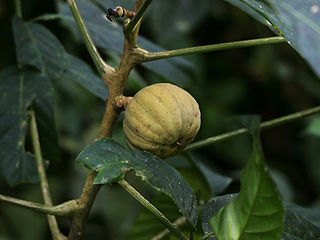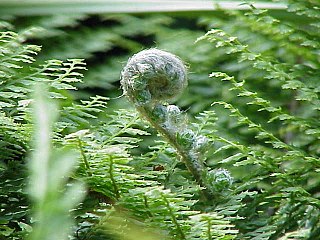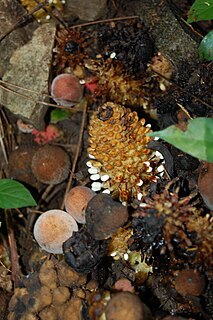
Mirabilis is a genus of plants in the family Nyctaginaceae known as the four-o'clocks or umbrellaworts. The best known species may be Mirabilis jalapa, the plant most commonly called four o'clock.

Chaetocarpus is a plant genus of the family Peraceae, formerly Euphorbiaceae, first described as a genus in 1854. Chaetocarpus species are trees or shrubs. There native to the Americas, Africa, and Asia. Some species are endangered.
- Chaetocarpus acutifolius(Britton & P.Wilson) Borhidi - Sierra de Moa in Cuba
- Chaetocarpus africanusPax - C Africa
- Chaetocarpus castanocarpus(Roxb.) Thwaites - SE Asia, Yunnan, Assam, Bangladesh, Sri Lanka
- Chaetocarpus cordifolius(Urb.) Borhidi - Cuba, Hispaniola, Jamaica
- Chaetocarpus coriaceusThwaites - Sri Lanka
- Chaetocarpus cubensisFawc. & Rendle - Cuba
- Chaetocarpus echinocarpus (Baill.) Ducke - Bolivia, Brazil
- Chaetocarpus ferrugineusPhilcox - Sri Lanka
- Chaetocarpus gabonensisBreteler - Gabon
- Chaetocarpus globosus(Sw.) Fawc. & Rendle - Jamaica, Cuba, Dominican Rep.
- Chaetocarpus myrsinitesBaill. - Bolivia, Brazil
- Chaetocarpus parvifoliusBorhidi - Cuba
- Chaetocarpus pearceiRusby - Bolivia
- Chaetocarpus pubescens(Thwaites) Hook.f. - Sri Lanka
- Chaetocarpus rabarabaCapuron - Madagascar
- Chaetocarpus schomburgkianus(Kuntze) Pax & K.Hoffm. - Colombia, Venezuela, 3 Guianas, NW Brazil

Hura is a genus of trees in the family Euphorbiaceae described by Carl Linnaeus in 1753. It is native to South America, Mesoamerica, and the West Indies.

Joannesia is a genus of plants in the family Euphorbiaceae, first described as a genus in 1798. The entire genus is endemic to Brazil.

Pseudanthus is a genus of plants under the family Picrodendraceae. The genus is endemic to Australia described as a genus in 1827.

Polystichum is a genus of ferns in the family Dryopteridaceae, subfamily Dryopteridoideae, according to the Pteridophyte Phylogeny Group classification of 2016. The genus has about 500 species and has a cosmopolitan distribution. The highest diversity is in eastern Asia, with about 208 species in China alone; the region from Mexico to Brazil has at least 100 additional species; Africa, North America, and Europe have much lower diversity. Polystichum species are terrestrial or rock-dwelling ferns of warm-temperate and montane-tropical regions. They are often found in disturbed habitats such as road cuts, talus slopes, and stream banks.

Jeffersonia, also known as twinleaf or rheumatism root, is a small genus of herbaceous perennial plants in the family Berberidaceae. They are uncommon spring wildflowers and grow in limestone soils of rich deciduous forests. Jeffersonia was named for United States President Thomas Jefferson by his contemporary Benjamin Smith Barton. This genus was formerly grouped in genus Podophyllum. Twinleaf is protected by state laws as a threatened or endangered plant in Georgia, Iowa, New York, and New Jersey.

Phyllospadix, surfgrass, is a genus of seagrass, a flowering plant in the family Zosteraceae, described as a genus in 1840. Phyllospadix grows in marine waters along the coasts of the temperate North Pacific.

Catabrosa is a small but widespread genus of plants in the grass family native to temperate areas of Eurasia, the Americas, and a few places in Africa.
Sphaerocaryum is a genus of Asian plants in the grass family. The only known species is Sphaerocaryum malaccense, native to southern China, Indochina, the Indian Subcontinent, Peninsular Malaysia, Philippines, and Sumatra.

Trisetum is a genus of plants in the grass family, widespread in temperate, subarctic, and alpine habitats in much of the world. Oatgrass is a common name for plants in this genus.

Desmostachya is a genus of grass in the family Poaceae.
Leptothrium is a genus of African, Asian, and Neotropical plants in the grass family.

Tofieldia is a small genus of flowering plants described as a genus in 1778. It is widespread across much of Europe, Asia, and North America.
Gaultheria trichophylla, commonly known as Himalayan snowberry, is a species of plant in the heath and heather family, native to the Himalayas. The flowers range in color from red, to pink, to white; fruits are blue-colored berries; and leaves are approximately 3 mm (0.12 in) in length.

Blyxa is a genus of an aquatic plant of the family Hydrocharitaceae described as a genus in 1806.

Balanophora is a genus of parasitic plants in the family Balanophoraceae found in parts of tropical and temperate Asia, including the Eastern Himalayas, Malesia region, Pacific Islands, Madagascar, and tropical Africa. There are about 20 accepted species, including the newly discovered B. coralliformis. Many species emit an odour which possibly attracts pollinators in the same way that pollinators are attracted to Rafflesia.

Morrenia is a genus of flowering plants in the family Apocynaceae, first described as a genus in 1838. It is native to South America.
Paxia is a genus of plants in the family Connaraceae, first described in 1891. It is native to west-central Africa.
Xylanche himalaica is a species of flowering plant in the family Orobanchaceae native to Asia. It was first formally named as Boschniakia himalaica in 1884 and transferred to the genus Xylanche in 1893. It is the only species in the genus Xylanche.















